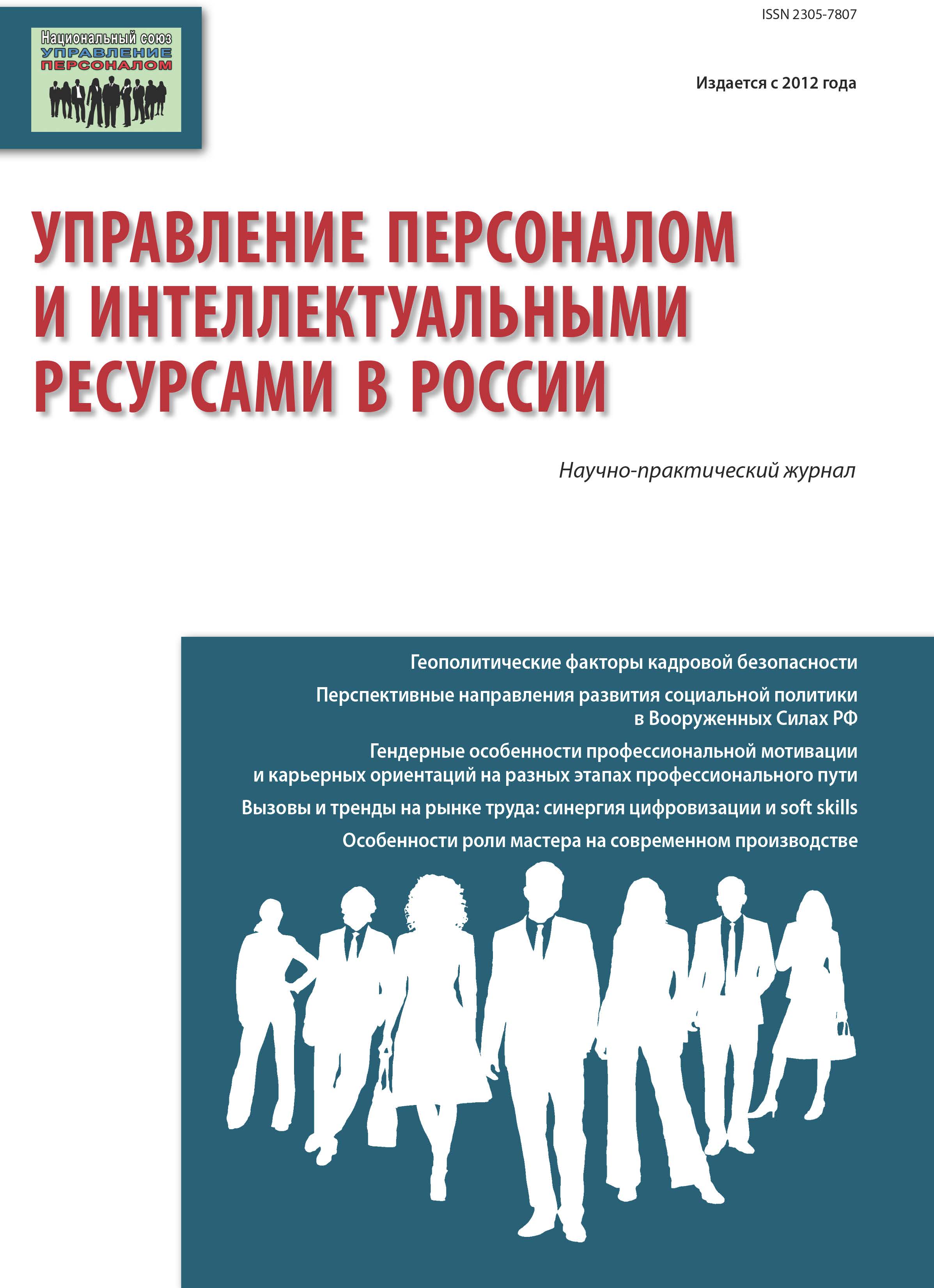Voronezh, Voronezh, Russian Federation
The aging of the workforce leads to a reduction in the able-bodied population, this why serious socioeconomic problems threaten both for the Russian economy and for organizations. One of the possible solution strategies to making working life in later ages longer is to change the policy of managing workers aged 45–50. The revision of many practices in age-managing leads to awareness of the need in new format of relations between employers and age employees known as “business partnerships”, which include the formation of a continuity of generations, the preservation of institutional memory, corporate culture. This approach also contains some risks caused by the peculiarities of the older workers, and Irrational system of personnel management. A systematic and complete definition of risks will allow organizations and employees to avoid threats or create opportunities for their compensation.
older workers, personnel management, personnel risks, risks of the personnel management system.
Одна из тенденций рынка труда развитых стран — сокращение работников трудоспособного возраста, связанное со старением населения. К 2050 г. в возрасте свыше 60 лет будет около одной трети населения европейский стран. Данные Росстата свидетельствуют об устойчивом росте численности населения старше трудоспособного возраста и в Российской Федерации. При этом удельный вес молодых работников (18–24 года) и работников в возрасте 25–49 лет уменьшается, что вызывает дефицит квалифицированных кадров. Среди методов сохранения высокого уровня занятости, наряду с привлечением труда мигрантов, офшорингом рабочей силы, называют увеличение в структуре занятых доли лиц старше трудоспособного возраста, что означает изменение политики использования работников 45–50 лет. Перед многими российскими организациями встанет проблема сочетания стратегии омоложения персонала с ответственным отношением к работникам старших возрастов.
1. Anan'ev B.G. Chelovek kak predmet poznaniya [Man as an object of knowledge]. St. Petersburg, Piter Publ., 2002. 288 p.
2. Badalova A.G., Moskvitin K.P. Upravlenie kadrovymi riskami predpriyatiya [Managing personnel risks of the enterprise]. Available at: https://bgscience.ru/lib/1437/
3. Danilina E.I. Innovatsionnyy menedzhment v upravlenii personalom [Innovative management in personnel management]. Moscow, «Dashkov i K°» Publ., 2016. 208 p. EDN: https://elibrary.ru/TXFYSZ
4. Durakova I.B. Pereotsenka tsennostey kak faktor transformatsii kadrovogo menedzhmenta [Revaluation of values as a factor in the transformation of personnel management]. Kadrovik [Kadrovik]. 2013, I. 11, pp. 72-78. EDN: https://elibrary.ru/RHMIZZ
5. Durakova I.B. Formirovanie bazy dlya ekonomicheskogo analiza rezul'tativnosti upravleniya personalom na urovne sotrudnikov organizatsii [Formation of the basis for the economic analysis of the effectiveness of personnel management at the level of the employees of the organization]. Ekonomicheskiy analiz: teoriya i praktika [Economic Analysis: Theory and Practice]. 2015, I. 13 (412), pp. 68-76. EDN: https://elibrary.ru/TNJBNT
6. Ivanova L.L. Riski v sisteme kadrovoy bezopasnosti [Risks in the system of personnel security]. Gosudarstvennoe i munitsipal'noe upravlenie. Uchenye zapiski SKAGS [State and municipal management. Scientific notes SKAGS]. 2015, I. 3, pp. 350-355. EDN: https://elibrary.ru/ULUAKN
7. Kapustina N.V. Riski upravleniya personalom [Risks of personnel management]. Ekonomika obrazovaniya [Economics of Education]. 2008, I. 4, pp. 139-142.
8. Konstantinov G.N. Universitety, obshchestvo znaniya i paradoksy obrazovaniya [Universities, knowledge society and education paradoxes]. Available at: https://vo.hse.ru/data/2013/10/20/1279375265/09konst0.pdf
9. Mitrofanova A.E. Sotsial'no-ekonomicheskoe soderzhanie i struktura kadrovykh riskov v organizatsii [Socio-economic content and structure of personnel risks in the organization]. Vestnik Moskovskogo gosudarstvennogo oblastnogo universiteta [Bulletin of the Moscow State Regional University]. 2013, I. 2. Available at: http://www.evestnik-mgou.ru/ru/Articles/Doc/317 EDN: https://elibrary.ru/QZOTIR
10. Pronina I.V. Otsenka kompetentsiy personala promyshlennogo predpriyatiya pri prinyatii upravlencheskikh resheniy. Kand. Diss [Evaluation of the competence of the personnel of an industrial enterprise when making managerial decisions. Cand. Diss]. Izhevsk, 2005. 20 p. EDN: https://elibrary.ru/NOGDWB
11. Solomanidina T.O. Kadrovaya bezopasnost' organizatsii [Personnel security organization]. Moscow, Al'fa-Press Publ., 2011. 688 p.
12. Taltynov S.M. Motivatsiya sotrudnikov pozhilogo vozrasta [Motivation of the elderly employees]. Kadrovik [Kadrovik]. 2013, I. 10, pp. 100-107. EDN: https://elibrary.ru/RHMIPZ
13. Trudovoy Kodeks Rossiyskoy Federatsii [The Labor Code of the Russian Federation].
14. Federal'nyy zakon ot 27.07.2004 № 79-FZ «O gosudarstvennoy grazhdanskoy sluzhbe Rossiyskoy Federatsii» [Federal Law No. 79-FZ of 27.07.2004 "On the Civil Service of the Russian Federation"].
15. A business case for worker sage 50+: a look at the value of experience, 2015 [elektronnyy resurs] http://www.aarp.org/content/dam/aarp/research/surveys_statistics/general/2015/A-Business-Case-Report-for-Workers%20Age%2050Plus-res-gen.pdf
16. Becker G. S. The economics of discrimination: second edition / G. S.Becker.- Chicago: University of Chicago Press.1971. - 178 pp.
17. Griffiths A. Designing and managing healthy work for older workers / A. Griffiths [elektronnyy resurs] http://www.ageingatwork.eu/resources/designing-and-managing-healthy-work-for-older-workers.pdf https://pdfs.semanticscholar.org/4170/16e7fb9ee6e8b4e03c48cf55af3c0423e4a9.pdf
18. Inceolgu I. Age-related differences in work motivation / I. Inceolgu, J. Segers, D. Bartram // Journal of Occupational and Organizational Psychology. - Vol. 85 (2012). PP. 300-329 [elektronnyy resurs] http://epubs.surrey.ac.uk/805608/1/Inceoglu%20et%20al%20age%20motivation%20JOOP2012.pdf
19. Kanfer R. Aging, adult development, and work motivation / R. Kanfer, P.A. Akerman //Academy of Management Review. -Vol. 29 (2004). -No. 3. - PP. 440-458 EDN: https://elibrary.ru/HDXHTZ
20. McNair S. Older people’s learning in 20125 a survey / S. McNair. - National Institute of Adult Continuing Education (Englandand Wales), 2012. - 51 pp. [elektronnyy resurs] http://shop.niace.org.uk/media/catalog/product/o/l/olderpeopleslearningin2012_full_web.pdf
21. Phelps E. The Statistical Theory of Racism and Sexism / E. Phelps // American Economic Review. - Vol. 62 (1972). - No. 4. - PP. 659-661. [elektronnyy resurs]http://www2.econ.iastate.edu/classes/econ321/orazem/Phelps_stat-discrimination.pdf
22. Theories of Occupational Segregation by Sex: an Overview // International Labour Review. - Vol. 136 (1997). - No 3. Cokrashchennoe izlozhenie v perevode s angliyskogo E.Mezentsevoy [A brief presentation in English from E. Mezentseva]. Gender i ekonomika: mirovoy opyt i ekspertiza rossiyskoy praktiki [Gender and economics: world experience and examination of Russian practice]. Moscow, ISEPN RAN - MTsGI - “Russkaya panorama” Publ., 2002. 352 p.
23. Walker A. Combating age barriers in employment / A. Walker. - Dublin, European Foundation for the Improvement of Living and Working Conditions, 1997. - 160 pp. [elektronnyy resurs] Available at: https://www.eurofound.europa.eu/sites/default/files/ef_publication/field_ef_document/ef9717en.pdf






